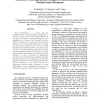LREC
2010
14 years 1 months ago
2010
In Chinese texts, words composed of single or multiple characters are not separated by spaces, unlike most western languages. Therefore Chinese word segmentation is considered an ...
LREC
2010
14 years 1 months ago
2010
Arabic is a morphologically rich language, which presents a challenge for part of speech tagging. In this paper, we compare two novel methods for POS tagging of Arabic without the...
COLING
2008
14 years 1 months ago
2008
Words in Chinese text are not naturally separated by delimiters, which poses a challenge to standard machine translation (MT) systems. In MT, the widely used approach is to apply ...
ACL
2008
14 years 1 months ago
2008
For Chinese POS tagging, word segmentation is a preliminary step. To avoid error propagation and improve segmentation by utilizing POS information, segmentation and tagging can be...
ACL
2007
14 years 1 months ago
2007
In this paper, we present a hybrid method for word segmentation and POS tagging. The target languages are those in which word boundaries are ambiguous, such as Chinese and Japanes...
FLAIRS
2007
14 years 2 months ago
2007
This paper describes a hybrid model that combines machine learning with linguistic heuristics for integrating unknown word identification with Chinese word segmentation. The model...
NLPRS
2001
Springer
14 years 4 months ago
2001
Springer
Word segmentation is the first and obligatory task for every NLP. For inflectional languages like English, French, Dutch,.. their word boundaries are simply assumed to be whitespa...
TSD
2005
Springer
14 years 6 months ago
2005
Springer
Human listeners use lexical stress for word segmentation and disambiguation. We look into using lexical stress for speech recognition by examining a Dutch-language corpus. We propo...
IJCNLP
2005
Springer
14 years 6 months ago
2005
Springer
Abstract. This paper proposes a lexicon-constrained character model that combines both word and character features to solve complicated issues in Chinese morphological analysis. A ...
ICDAR
2007
IEEE
14 years 6 months ago
2007
IEEE
Word segmentation is a crucial step for segmentation-free document analysis systems and is used for creating an index based on word matching. In this paper, we propose a novel met...




